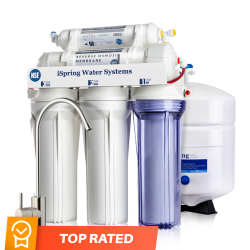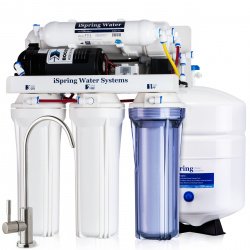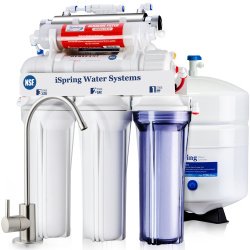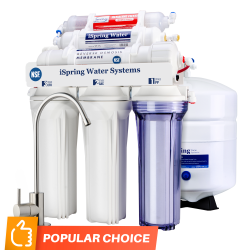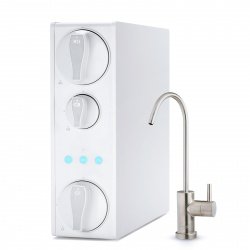
If you drink municipal city water your tap water is regulated by EPA standards and local city ordinances, however, many reports, including analysis from the Environmental Working Group, consider these standards much too lenient. If you drink well water, you likely already know that you are responsible for testing and treating your water.
Even if you are comfortable with EPA standards your tap water is likely picking up additional contaminants such as lead and pesticide runoff as it flows from the city’s treatment facility to your home.
The most common water containment is one introduced by your local water treatment facility: Chlorine. Chlorine is highly toxic and is used as a cheap but effective way to prevent bacteria from causing waterborne diseases and illnesses. Unfortunately, chlorine also introduces trihalomethanes (THMs) into our water. THMs are known to increase your risk of asthma, bladder cancer, and heart disease.
What is a Reverse Osmosis Water Filter?
The Reverse Osmosis (RO) water filtration technique is one of the most effective filtration devices. The process works by forcing water through an RO membrane that removes most of the toxin from large sediments to small contaminants like chlorine and THMs.
RO systems use a series of filters to clean water for specific impurities. This makes the RO system highly versatile and customizable for your local water source and the containments you are concerned about.
Reverse Osmosis Water Filter with a Tank
The Traditional Reverse Osmosis (RO) Filtration System works by forcing water through a series of filtration devices and a water-permeable membrane. While it is incredibly effective at purifying water, it does need some time to squeeze the water molecule through the RO membrane and can reduce the amount of water coming out of your tap. Filtration manufacturers solved this issue with the use of a storage tank that will fill with purified water ready for immediate use.
Advantages:
- 1. More affordable than tankless options.
- 2. Stores purified water that can be accessed in case of emergencies.
- 3. Does not require a power supply, except for a system with a pump or an UV filter
Disadvantages:
- 1. A large system that requires more space to set up.
- 2. If water is stored too long it may begin to taste ‘off’.
Tankless Reverse Osmosis Water Filter
Tankless Reverse Osmosis (RO) Filtration Systems are the latest iteration of the RO water filter. These devices are easier to manage, more compact, and produce fresher water. They were designed to provide the same level of purification as a traditional RO system while taking up less space and purifying water as it is needed rather than letting water sit in a storage tank.
Advantages:
- 1. Takes up significantly less space than a traditional RO system.
- 2. Since the water is not stored in a tank, many find this filtration system tastes ‘fresher’.
- 3. Produces less wastewater than traditional RO systems, reducing your water bill.
Disadvantages:
- 1. Higher upfront investment.
- 2. Requires an electric power to have this system work
- 3. Because there is no storage tank, this system cannot store water that could be accessed in case of emergencies.
The Gold Standard in RO Water Filtration
All RO systems are built differently. iSpring takes pride in producing the highest quality water filtration devices to deliver exceptional quality every time you turn on a faucet.
iSpring offers several types of traditional RO water filters, the iSpring RCC7, iSpring RCC7AK and the iSpring RCC7AK-UV. As well as the iSpring RO500, the next generation tankless RO water filtration system
iSpring RCC7
• Traditional Tank RO System• Certified to NSF/ANSI 58 for TDS reduction.
• Removes up to 99% of over 1, 000 harmful contaminants including chlorine, fluoride, lead (removes up to 98%), arsenic, asbestos, calcium, sodium, and more.
iSpring RCC7AK
• Traditional Tank RO System• Certified to NSF/ANSI 58 for TDS reduction.
• Removes up to 99% of over 1, 000 harmful contaminants including chlorine, fluoride, lead (removes up to 98%), arsenic, asbestos, calcium, sodium, and more.
• Restores the natural alkalinity and mineral balance of water, improving both the taste and the nutritional benefits of your water.
iSpring RCC7AK-UV
• Traditional Tank RO System• Boasts all of the features of the RCC7AK while also featuring a UV light to treat the well
• The optimal option for homes receiving water from well and other unreliable water sources like lakes and streams.
iSpring RO500
• Tankless RO System• A fast flow rate of 0.4 gallons per minute makes this an ideal filtration device for both residential and commercial use.
• Effectively removes TDS, limescale, up to 99% of over 1,000 contaminants, including lead (removes up to 98%), chlorine, fluoride, arsenic, asbestos, calcium, sodium, and more.
• 3rd stage Carbon Block Filter further enhances the taste of the purified water.
• Saves water waste by up to 400% compared to a traditional RO system.
• Comes with a high-quality smart faucet that monitors TDS water quality in real-time.
• Filter changes are quick and easy. Sensors alert you to the need to change the filters so you don’t have to keep track of the replacement schedule.
There are so many options!
The list of benefits and features of iSpring’s RO systems goes on and on and may feel overwhelming for someone trying to upgrade their home’s water filtration system. iSpring wants to help you evaluate your options and choose the right device for you and your family.
The friendly and knowledgeable customer service representatives are available from 9-5 EST by phone (678) 261-7611 Monday through Friday or by email at support@123filter.com. We look forward to hearing from you!


